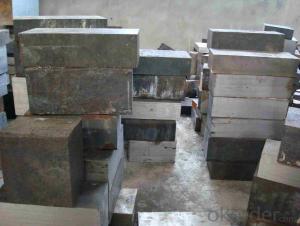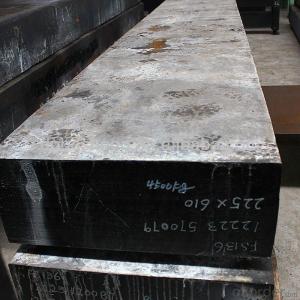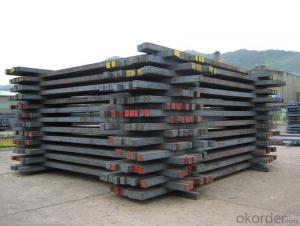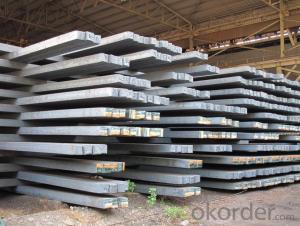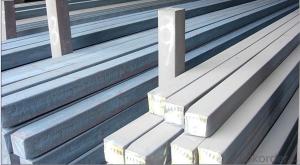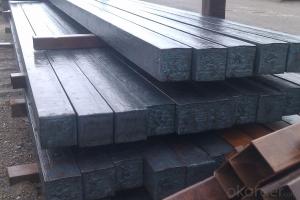Prime square alloy steel billet 110mm Q235
- Loading Port:
- Shanghai
- Payment Terms:
- TT OR LC
- Min Order Qty:
- 100 m.t.
- Supply Capability:
- 10000 m.t./month
OKorder Service Pledge
OKorder Financial Service
You Might Also Like
Structure of Prime square alloy steel billet 105mm Q235

Description of Prime square alloy steel billet 105mm Q235
1. Prepainted steel coil is coated with organic layer, which provides higher anti-corrosion property and a longer lifespan than that of galvanized or galvalume steel sheets.
2. The base metals for prepainted steel coil consist of cold rolled, HDGI Steel, electro-galvanized and hot-dip alu-zinc coated steel. The finish coats of prepainted steel coil can be classified into groups as follows: polyester, silicon modified polyesters, polyvinylidene fluoride, high-durability polyester, etc.
3. The production process has evolved from one-coating-and-one-baking to double-coating-and-double-baking, and even three-coating-and-three-baking.
4. The color of the prepainted steel coil has a very wide selection, like orange, cream-colored, dark sky blue, sea blue, bright red, brick red, ivory white, porcelain blue, etc.
5. The prepainted steel coils can also be classified into groups by their surface textures, namely regular prepainted sheets, embossed sheets and printed sheets.

Main Feature of Prime square alloy steel billet 105mm Q235
Uncoated CR steel sheet
With the features of in line with the international highest standards in demension and shape, excellent surface finish and properties, the products are mainly used in home appliance and automobile industries.
Galvanized steel sheet(include HDG and EG)
With the features of good corrosion resistance, the products are mainly used in automobile, home appliance, electronics, building and machinery manufacture industries, etc.
Precoated steel sheet
With the features of enviromental protection and good processablility, long lasting surface durability, rich in colors, the products are maily used in building, home appliance and furniture industries, etc.
Applications of Prime square alloy steel billet 105mm Q235
1) Excellent corrosion resistance: The zinc layer provides a good protection of Pre-painted Galvanizeed Steel Sheet.
2) High heat resistance: The reflective surface of the material aids in efficiently reflecting the sunlight away and in turn reducing the amount of heat transmitted. The thermal reflectivity converts into energy savings.
3) Aesthetics: Pre-Painted Galvanized steel sheet is available in plethora of patterns and multiple sizes as per the requirements that given by our customers.
4) Versatility: can be used in the various areas.

Specifications of Prime square alloy steel billet 105mm Q235
Product | Billet |
Material Grade | SGCC / SGCH / DX51D+AZ, etc |
Thickness | 0.6-3.0mm |
Width | 500-1500mm |
Tolerance | Thickness: +/-0.02mm , Width:+/-2mm |
Zinc-coating | Z30-150g/m2 |
Technique | Raw material: Hot rolled steel coil --> Cold rolled_>hot dipped galvalume |
Surface | Dried, Chromated, Unoiled |
Spangle | Regular spangle , small spangle, zero spangle |
ID | 508MM 610MM |
Coil weight | 1-25MT |
Export package | Cardboard inner sleeves, Waterproof paper, galvanized steel covered and steel strip packed |
FAQ of Prime square alloy steel billet 105mm Q235
We have organized several common questions for our clients,may help you sincerely:
1. How Can I Visit There?
Our company is located in Tianjin City, China, near Beijing. You can fly to Tianjin Airport Directly. All our clients, from home or aboard, are warmly welcome to visit us!
2. How Can I Get Some Sample?
We are honored to offer you sample.
3. Why choose CNBM?
we always fix steel produce in container well to make it safe arrive at destination port
we always provide best and professional forward service for our buyer
we always apply 14days free detention for our buyers container in destination
we provide one set After-sales service for our buyer
we provide China inland steel market price report
we help our buyer become number one in local market .
- Q:What are the different types of steel billet reheating furnaces?
- There are several different types of steel billet reheating furnaces used in the metal industry. These furnaces are designed to heat steel billets to a specific temperature before they are further processed or shaped into various end products. The main types of steel billet reheating furnaces include: 1. Pusher Type Furnace: This type of furnace uses a pusher mechanism to move the billets through the furnace. The billets are loaded onto a roller conveyor and pushed into the furnace using mechanical pusher plates. As the billets move through the furnace, they are heated by the combustion gases or electrical heating elements. 2. Walking Beam Furnace: In a walking beam furnace, the billets are placed on a series of moving beams or skids. These beams move in a continuous loop, carrying the billets through the furnace. As the billets move, they are heated by the burners or electrical heating elements located above and below the beams. 3. Rotary Hearth Furnace: This type of furnace consists of a rotating hearth on which the billets are placed. The hearth rotates, bringing the billets through different temperature zones within the furnace. The billets are heated by the burners or electrical heating elements located above the hearth. 4. Continuous Furnace: A continuous furnace is a type of furnace where the billets are continuously fed into one end and discharged from the other end. The billets move through the furnace on a conveyor belt or roller conveyor, being heated by the combustion gases or electrical heating elements as they pass through. 5. Walking Hearth Furnace: In a walking hearth furnace, the billets are placed on a hearth that moves in a reciprocating motion. The hearth moves back and forth, bringing the billets through the furnace. The billets are heated by the burners or electrical heating elements located above and below the hearth. Each type of steel billet reheating furnace has its own advantages and is suitable for specific applications. The choice of furnace depends on factors such as the required heating capacity, the size and shape of the billets, the desired temperature profile, and the energy efficiency requirements.
- Q:How are steel billets used in the manufacturing of industrial machinery?
- Steel billets are an essential component in the manufacturing of industrial machinery. These billets are semi-finished products that are produced through a process called continuous casting, where molten steel is poured into a mold to form a solid rectangular shape. Once the steel billets are formed, they undergo various processes to transform them into different components of industrial machinery. One common use of steel billets is in the production of machine parts such as gears, shafts, and axles. These components require high strength and durability to withstand the rigorous demands of industrial applications, and steel billets provide the necessary material properties. Steel billets are also used in the manufacturing of large structural components such as frames, bases, and supports for industrial machinery. These components need to be able to handle heavy loads and provide stability, and the use of steel billets ensures the necessary strength and rigidity. Furthermore, steel billets serve as raw material for forging, where they are heated and shaped using mechanical force to create complex shapes like crankshafts and connecting rods. The high malleability and ductility of steel billets make them ideal for forging, allowing manufacturers to produce intricate and precise components for industrial machinery. In addition, steel billets are often used in the production of specialized machinery, such as rolling mills and presses, which are used in various industrial processes. These machines require robust components that can withstand high temperatures, pressures, and forces, and steel billets provide the necessary strength and resilience. Overall, steel billets play a vital role in the manufacturing of industrial machinery as they provide the necessary strength, durability, and versatility required for producing various components and structures. Their use ensures the reliability and performance of industrial machinery in a wide range of applications.
- Q:What are the different surface treatments applied to stainless steel billets?
- Stainless steel billets can undergo several surface treatments to enhance their appearance and improve their resistance to corrosion. Some commonly used surface treatments include: 1. Pickling: By immersing the billets in an acid bath, like nitric or hydrofluoric acid, any scale or oxide layers formed during the manufacturing process can be removed. Pickling restores the stainless steel's original finish and provides a clean and smooth surface. 2. Passivation: This chemical process is employed to boost the corrosion resistance of stainless steel. By immersing the billets in an oxidizing solution, usually a nitric acid bath, any embedded iron or contaminants are eliminated from the surface. Passivation creates a thin oxide layer on the stainless steel surface, which aids in preventing corrosion and maintaining the integrity of the material. 3. Electropolishing: This electrochemical process involves removing a thin layer of material from the billet's surface. By passing an electric current through the billets while they are submerged in an electrolyte solution, the surface becomes smoother and any defects or impurities are eliminated. Electropolishing not only enhances the appearance of stainless steel but also improves its corrosion resistance and facilitates cleaning. 4. Grinding and polishing: These mechanical processes utilize abrasive materials to eliminate imperfections or irregularities from the stainless steel billets' surface. Grinding is achieved using a coarse abrasive wheel, while polishing involves progressively finer abrasives to achieve a smooth and reflective surface. These processes can produce various finishes, ranging from a brushed or satin finish to a mirror-like polished finish. These different surface treatments can be utilized individually or in combination to achieve the desired appearance and performance characteristics for stainless steel billets in diverse applications.
- Q:What is the typical weight of a steel billet?
- The typical weight of a steel billet can vary depending on the specific dimensions and requirements, but it is commonly found to range between 1,000 to 5,000 kilograms or 2,205 to 11,023 pounds.
- Q:What are the disadvantages of using steel billets?
- There are several disadvantages of using steel billets in various industries. Firstly, steel billets are quite heavy and bulky, making them difficult to handle and transport. This can increase logistical challenges and costs, especially when large quantities of billets need to be moved. Secondly, steel billets require a significant amount of energy and resources to manufacture. The production process involves melting down iron ore and various additives, which consumes a substantial amount of energy and contributes to carbon emissions. This makes steel billets less environmentally friendly compared to other materials. Additionally, steel billets have limited versatility in terms of shape and size. Their initial form is typically a long, rectangular bar, which limits their applicability in certain industries that require complex or intricate shapes. This can lead to additional processing steps and costs to transform the billets into desired forms. Furthermore, steel billets have a high risk of surface defects and internal flaws. During the manufacturing process, impurities and non-uniformities can occur, leading to cracks, inclusions, or segregations within the billets. These defects can compromise the structural integrity and performance of the final product, potentially resulting in failures or safety risks. Lastly, steel billets are susceptible to corrosion, particularly in harsh or corrosive environments. This can significantly reduce their lifespan and necessitate frequent maintenance or protective coatings to prevent deterioration. The costs associated with corrosion prevention and maintenance can add up over time, making steel billets less cost-effective in certain applications. Overall, while steel billets are widely used due to their strength and durability, their disadvantages in terms of weight, energy consumption, limited versatility, potential defects, and susceptibility to corrosion should be taken into consideration when choosing the appropriate material for a specific application.
- Q:What does the billet of the steel plant refer to?And steel what is the difference?
- Billet is the product of molten steel made by steelmaking furnace. After casting, the billet can be divided into two kinds: casting blank and continuous casting billet. At present, the casting process has been basically eliminatedRefers to the use of reinforced and prestressed concrete with steel reinforced concrete, the cross section is circular, sometimes square with rounded corners. Including round bars, ribbed steel bars, steel torsion bar.
- Q:What are the safety measures involved in handling steel billets?
- When handling steel billets, there are several important safety measures that should be followed to ensure the well-being of workers and prevent accidents. 1. Personal Protective Equipment (PPE): It is essential for workers to wear appropriate PPE, such as safety goggles, gloves, steel-toed boots, and helmets, to protect themselves from potential hazards. This equipment provides protection against sharp edges, flying debris, and falling objects. 2. Training: Proper training is crucial for workers involved in handling steel billets. They should be trained in safe lifting techniques, handling procedures, and the use of equipment like cranes or forklifts. This knowledge will help minimize the risk of musculoskeletal injuries and accidents caused by improper handling. 3. Equipment Inspection: Regular inspection of equipment, such as cranes, hoists, and lifting slings, is crucial to ensure their proper functioning. Any defects or malfunctions should be reported and repaired promptly to prevent accidents. 4. Secure Storage: Steel billets should be stored in a secure and organized manner to prevent them from falling or tipping over. Proper racking systems and storage areas should be used to ensure stability and prevent accidents due to falling objects. 5. Adequate Lighting: Good lighting is essential in the working area to ensure clear visibility and prevent accidents caused by tripping or colliding with objects. 6. Floor Conditions: The floor should be kept clean and free from hazards, such as oil spills or debris, that could cause slips, trips, or falls. Regular cleaning and maintenance are necessary to ensure a safe working environment. 7. Communication: Clear communication among workers involved in handling steel billets is crucial to prevent accidents. Signals, hand gestures, and use of radios or other communication devices can help coordinate movements and prevent collisions or accidents. 8. Emergency Preparedness: Adequate emergency preparedness measures should be in place, including fire extinguishers, first aid kits, and evacuation plans. Workers should be trained in emergency procedures to ensure a swift and safe response in case of an incident. By following these safety measures, risks associated with handling steel billets can be minimized, ensuring a safer work environment for all involved.
- Q:How to calculate the cost price of billet?
- The ratio of slag to billet (63% fine powder) is about 3:1, which accounts for about 60%. of billet cost
- Q:What are the different types of steel billet rolling techniques?
- There are several different types of steel billet rolling techniques, including hot rolling, cold rolling, and continuous casting.
- Q:How are steel billets cleaned before further processing?
- Steel billets are typically cleaned before further processing through a process known as descaling. This involves removing any mill scale or oxides on the surface of the billets using techniques such as shot blasting, pickling, or high-pressure water jetting. The cleaned billets are then ready for subsequent processing steps such as hot rolling or forging.
1. Manufacturer Overview |
|
|---|---|
| Location | |
| Year Established | |
| Annual Output Value | |
| Main Markets | |
| Company Certifications | |
2. Manufacturer Certificates |
|
|---|---|
| a) Certification Name | |
| Range | |
| Reference | |
| Validity Period | |
3. Manufacturer Capability |
|
|---|---|
| a)Trade Capacity | |
| Nearest Port | |
| Export Percentage | |
| No.of Employees in Trade Department | |
| Language Spoken: | |
| b)Factory Information | |
| Factory Size: | |
| No. of Production Lines | |
| Contract Manufacturing | |
| Product Price Range | |
Send your message to us
Prime square alloy steel billet 110mm Q235
- Loading Port:
- Shanghai
- Payment Terms:
- TT OR LC
- Min Order Qty:
- 100 m.t.
- Supply Capability:
- 10000 m.t./month
OKorder Service Pledge
OKorder Financial Service
Similar products
New products
Hot products
Related keywords
